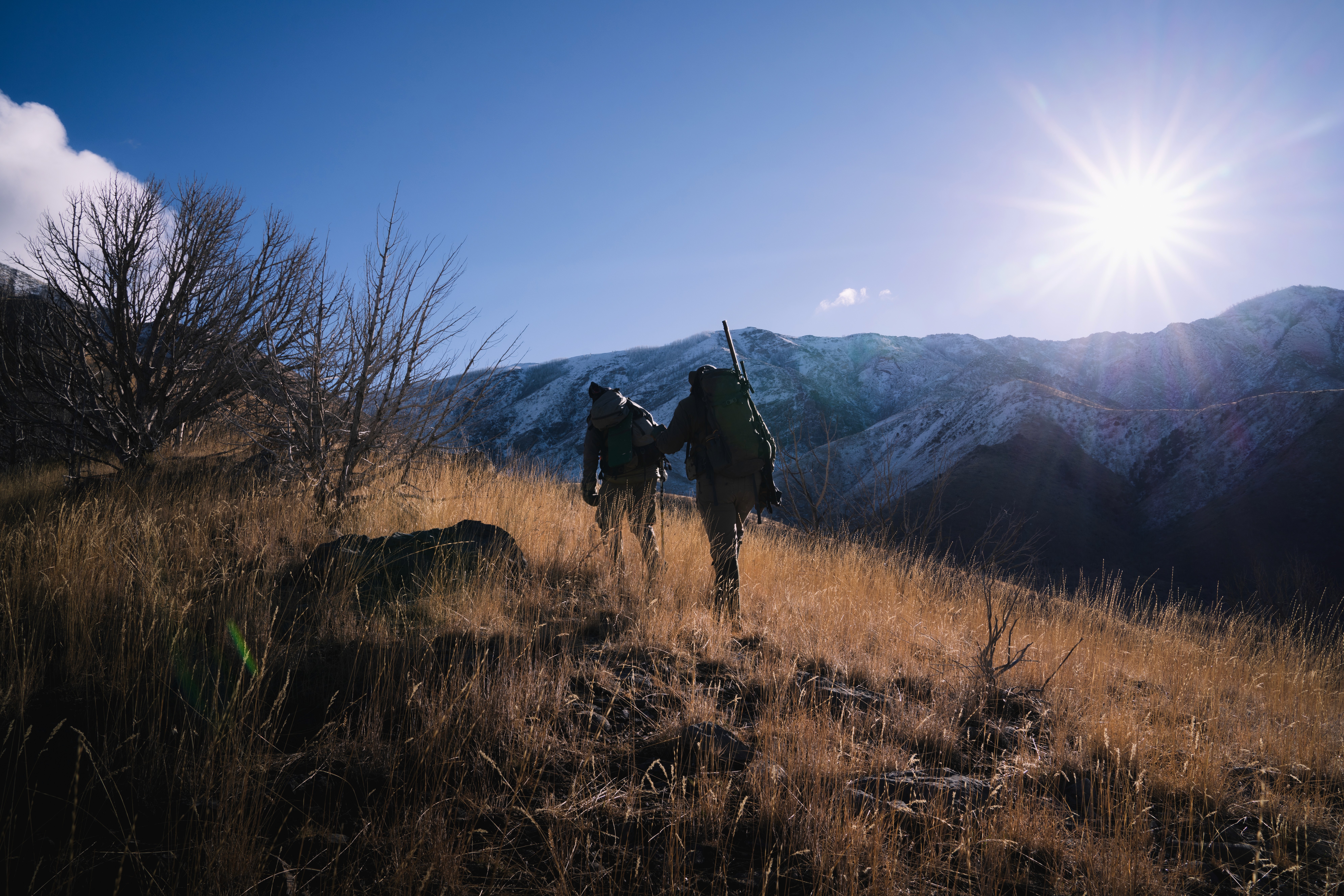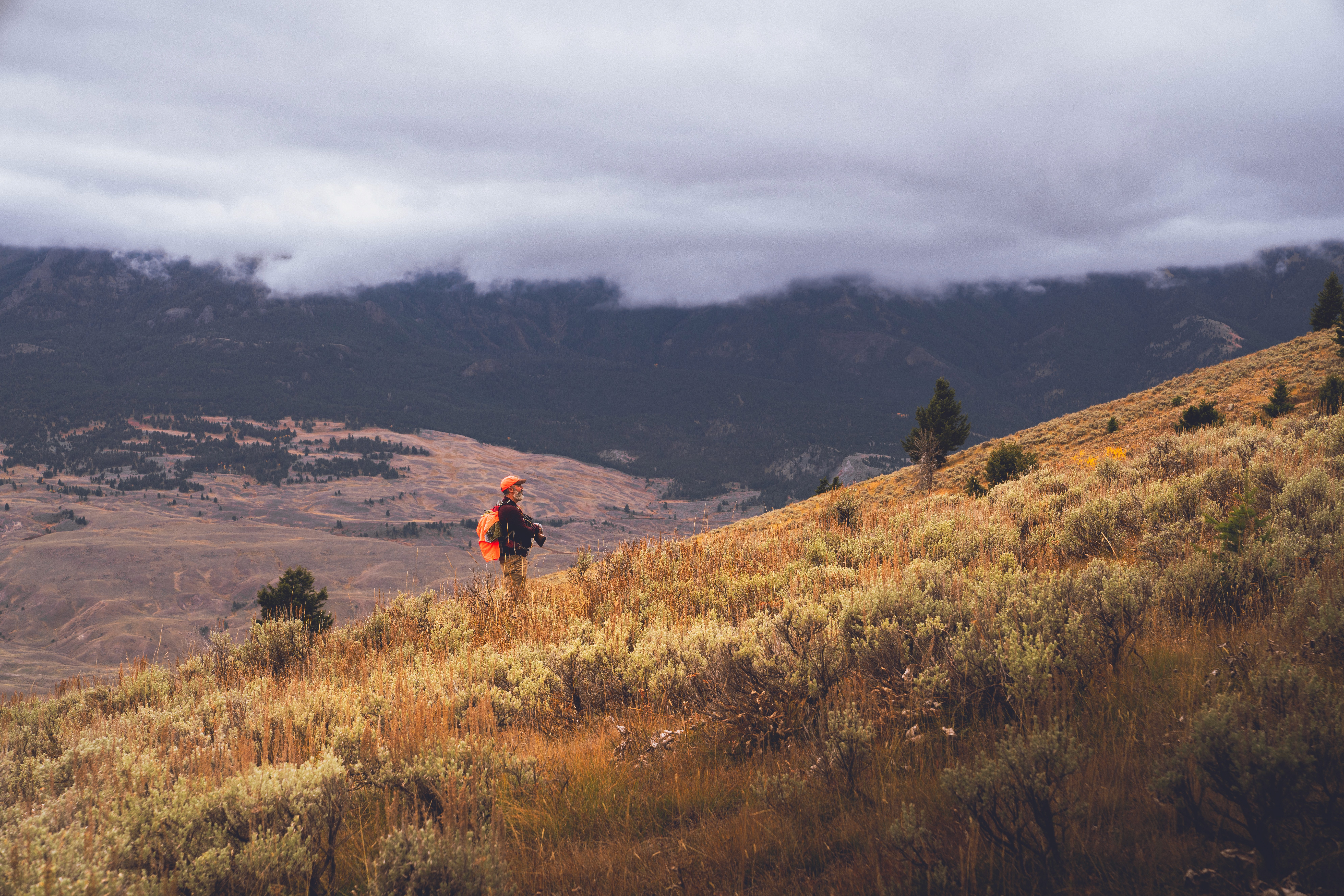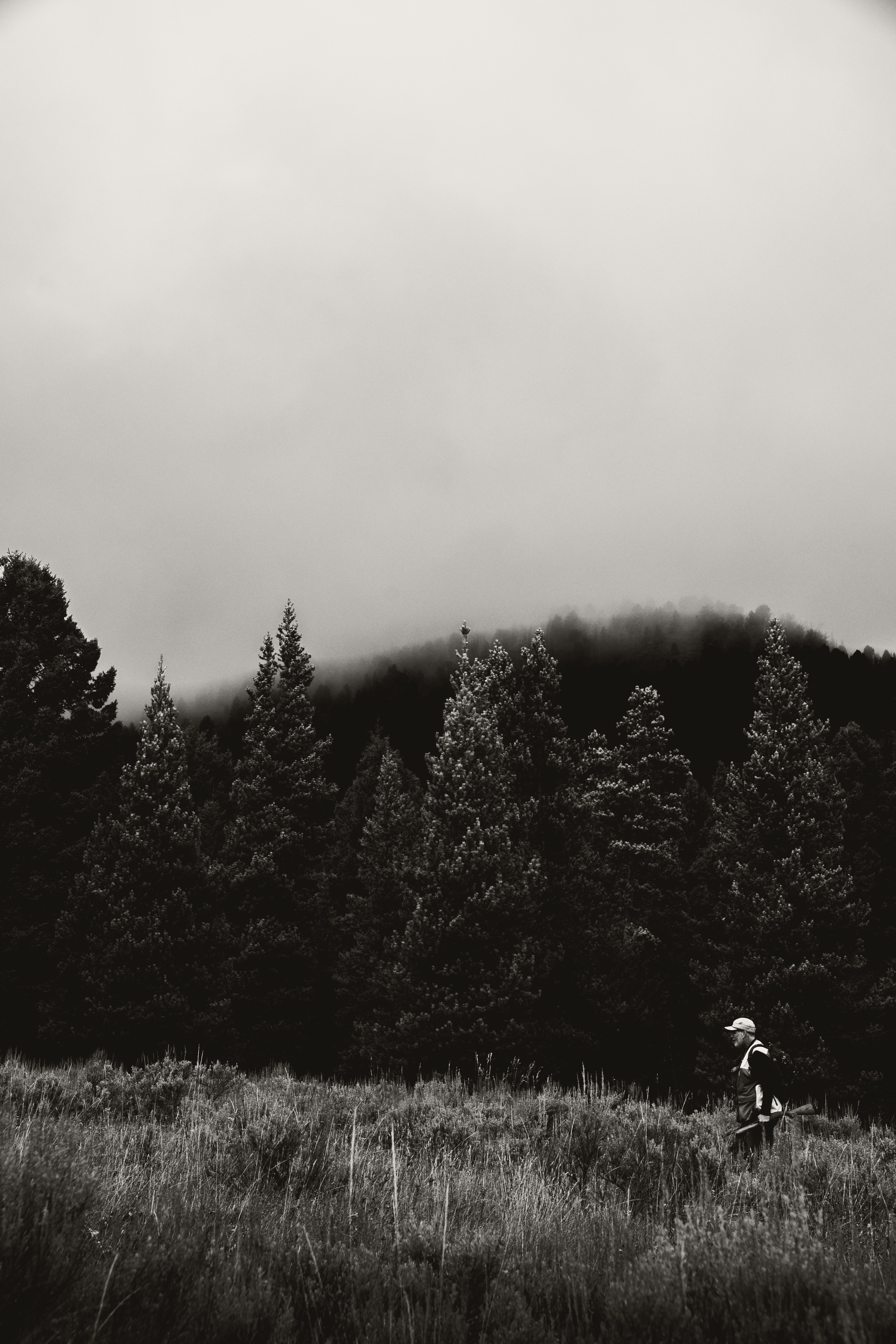



Elk Hunting
How to Train for Late Season Elk Hunting Fitness
It seems like a lot of elk hunters have a problem.
They spend a good portion of the year prepping for September. They dump hours of effort into each week leading up to archery season. Then, October hits and all the focus they had during the first nine months of the year goes out the window. It’s as if rifle season is an afterthought, even though there’s a tag tucked into their hunting pants. But I’ve realized something.
It’s not that elk hunters lose focus or that rifle season is an afterthought. They’re just unclear on what to do to train for late season elk hunting fitness. That’s understandable. There isn’t a lot of good info out there on how to transition training between elk seasons. I’ve set out to change that with this article.
We’ll cover how to maintain the elk hunting fitness built during the lead up to archery season, and we’ll talk about how to specifically prepare for the cold weather shift into late season elk hunting.
Why You Can’t Slack on Fitness Before Late-Season Elk Hunts
Sure, it’d be nice if you could ride the wave from all of your summer training right through September and into the rest of hunting. But, friend, it just doesn’t work that way. Use it or lose it is real in the case of fitness. If you don’t train to at least maintain what you’ve built, your fitness will go the way of your preference points when you forget to apply for a tag. You can’t just rely on your summer work to carry you through the entire fall. You have to keep training.
Late season elk hunting also has specific demands that differ from archery season’s late summer hunts. They’re a little sneaky, and they all add up to one thing.
The energy cost of a late-season elk hunt is higher than an early-season hunt. One of the biggest reasons is temperature regulation. It costs you way more energy to stay warm than it does to stay cool. That means you need to be even more efficient as you move through the mountains. You can’t afford to waste energy, so you can’t afford to let your fitness slack.
There’s also a real good chance you’ll deal with some snow. You know how taxing it is to march through the powder on flat ground and without hauling any weight. Add terrain and a heavy pack to the pot, and you have a cold recipe for fatigue. It’s important to do specific strength training and conditioning to make sure you’re not served too big a helping of that cold dish.
And even though the elk should be lower, you’ll still likely have to deal with altitude. Altitude’s negative effects are far greater when you’re fatigued. Wear yourself out because you’re not fit enough to deal with the cold and snowy terrain, and you could walk yourself right into altitude sickness. You’ll at least have a worse time and set yourself up to miss shot opportunities because elevation is kicking your ass.
Let’s talk about how to make sure that doesn’t happen.
Building Between Seasons: The Fitness Foundation for Late-Season Elk Hunting
We have to answer the question, how do we train to stave off fatigue from the cold and moving on snowy terrain with weight on our backs? The general answer is by building specific strength and efficiency. We’ll get into the specifics of each in their own sections. First, let’s talk about training structure based on what you should include in your endurance training for late elk season.
Each training week should include:
Zone 1 / Zone 2 training to maintain or improve your aerobic base
Zone 3 training to maintain or improve your carb-burning efficiency
1-2 strength training sessions that include hip-strengthening exercises
Ruck training to stay efficient under load
Plenty of mobility training
Your conditioning (Zone 1/Zone 2/Zone 3) should be specific to moving in the mountains. If you have easy access to terrain, it’s best that you get on it. If you don’t, you’ll be shaking hands with the stairclimber and the incline treadmill every week. You can dispatch two fowl with one rock by putting a pack on during some of those workouts.
You need the Zone 1 and Zone 2 work to maintain your overall metabolic efficiency, as well as to train your ability to recover. It’s important to use fat for fuel for as long as possible. That maintains your metabolic efficiency, meaning you can move for longer without fatiguing. Having aerobic efficiency is also super important for going to altitude. You have less access to oxygen, so you need to use it as efficiently as possible. And you won’t be able to do that without enough low-intensity aerobic training. Your aerobic system is also your recovery system. If you don’t maintain it, it’ll be a lot harder to get your shit together after a hard uphill climb. You also won’t recover as well between hunts.
No matter how good you are at utilizing fat for fuel, you will end up burning carbs during late season elk hunts. Uphill climbs, if they’re long enough, steep enough, or have enough snow, will eventually raise your heart rate to the point where your body switches to carbs for its main fuel source. That makes Zone 3 training important before sling your rifle on your pack and head off into the mountains. Zone 3 training improves your carb-burning efficiency. That means you’ll improve the channels your body uses to burn them. It also means that you’ll need to burn less carbs to do the same amount of work, saving energy that delays fatigue and improving your recovery between hikes and hunts.
Including specific uphill and downhill strength work is kind of a no-brainer. However, most hunters don’t think about the specific hip strength necessary to move through snow. And most hunting fitness programs don’t address it. You need it if you don’t want to burn out your hips and your back.
Efficiency under load is also a no-brainer. If you’ve done a lot of rucking up to this point in the year, you need to do enough work to maintain it. If you haven’t it needs to be a main focus of your training.
Mobility training keeps our joints healthy while ensuring that we move well. Moving well means moving efficiently. We save a whole lot of energy when we move efficiently.
Conditioning for Late-Season Elk Hunts: Cold Weather, Terrain, and Snow
Before we get into the specifics of conditioning for late season elk hunts, I’ll note that it’s important to get outside for as much of this work as possible. It’s damn near impossible to train for thermoregulation in a gym’s climate controlled environment. Get outside.
We talked about Zone 1, Zone 2, and Zone 3 training in the previous section. But what does that look like in practice while training for elk hunting in cold weather and on steep terrain?
It looks like 2 - 3 total hours of easy rucking on rolling terrain in Zones 1 and 2. And it looks like 1 uphill Zone 3 session with a pack on. It’s best if one of the Zone 1/Zone 2 sessions lasts for at least an hour — 90 minutes would be better.
Steady state intervals are great for Zone 3 training. Here’s an example of how to do them:
Warm-up at easy pace, keeping your heart rate in Zones 1 and 2 for 15 minutes
Increase your speed and keep your heart rate in Zone 3 for 15 to 25 minutes
Slow down and recover in Zone 2 for a 3 to 5 minutes
Do another 15- to 25-minute Zone 3 interval
Cool down for 15 minutes, working your heart rate down into Zone 1
If you don’t have ready access to terrain, do your Zone 1 / Zone 2 session on a treadmill inclined to at least 10 degrees. Do your Zone 3 session on the stairclimber, if you have access to one. If not, do your Zone 3 session on a treadmill inclined to at least 15 degrees.
Strength Training for Late Season Elk Hunts: Uphill Drive, Downhill Control, and Hip Strength for Deep Snow
Truth be told, the ruck training listed in the last section is a specific type of strength training for late season elk hunts. However, it doesn’t cover all your bases. It’s still important to get in the gym. You’ll need it to stay healthy and for the leg strength that keeps you cruising on terrain. On top of that, it’s where you’ll build the hips you need to trudge through snow should it fall deeply enough.
Your leg strength training doesn’t need to be fancy. Front squats, split squats, lunges, step-ups, stability ball hamstring curls, RDLs, and single-leg RDLs done in a moderate rep range (4 - 10 reps) are great. Accompany those movements with normal upper-body strength training and core training and you’re in a solid spot. Break that all up over 1-2 days per week.
You’ll include mobility training during your strength sessions, using it as the main part of your warm-up and doing mobility exercises between sets of strength exercises. Focus on your ankles, hips, spine, and shoulders.
You’ll also do specific hip flexor strengthening exercises during those sessions. You can build them into your warm-up, or do them along with some power training before you get into your strength work. I’ll offer you three examples that we use throughout the year in our Packmule training programs.
Standing Hip Flexor Isometric Hold: Do a few sets of 10- to 30-second holds per side
Hip Flexor Sit-up: Do a few sets of 5 to 10 reps per side.
Loaded Hip Flexor Reach: Do a few sets of 5 reps per side.
If you’ve never done any direct hip flexor training before, start with the isometric hold. After a couple of weeks, you can start working on the other exercises. It is important to eventually do the hip flexor sit up and the loaded hip flexor reach because each builds strength at each end of the hip flexor’s range of motion.
Structuring Your Weekly Training Schedule for Late Season Elk Hunts
Okay, here’s what your late season elk hunting fitness plan looks like laid out in a weekly schedule. This setup allows you to maximize the benefits of each type of training because it creates an ebb and flow of training intensity and training volume. Let’s have a look.
Monday: Strength (Front Squats + Chin-ups + Single-Leg RDLs + Step-ups)
Tuesday: 60 Minutes Zone 1 / Zone 2
Wednesday: Off or Easy Mobility Work
Thursday: Steady State Zone 3 Intervals
Friday: Strength (Spit Squats + Dumbbell Bench Press + RDLs + Reverse Lunges)
Saturday: 90+ Minutes Zone 1 / Zone 2
Sunday: Off or Easy Mobility Work
If you follow this structure for the month leading up to your late season hunt, you’ll be well-prepared for mountains, snow, and long, heavy walks with elk quarters on your back.
Below you’ll find a couple sample training days to help you dial in your training plan.
Sample Strength and Conditioning Days for Late Season Hunts
Since the strength sessions and the Zone 3 sessions are the most complicated to plan, I’ll use them to offer examples as you build your late season elk hunting fitness plan.
Check those puppies out below.
Monday Strength Session Example
All exercises with the same letter in front of them are done in series as a super set.
Start by doing a mobility-based warm-up before starting the A exercises.
A1. Vertical Jump 3 x 5
A2. Standing Hip Flexor Isometric: 3 x 15-seconds per side
A3. Quadruped Hip CARs: 3 x 3 per side
B1. Front Squat: 4 x 4
B2. Chin-ups: 4 x 4
B3. ½ Kneeling T-Spine Rotation: 4 x 3 per side
C1. Single-Leg RDLs: 2 x 8 per side
C2. Goblet Box Step-ups: 2 x 8 per side
Use this same template to construct your Friday strength workout.
Thursday Steady State Zone 3 Intervals Example
Start by doing a mobility-based warm-up before starting the warm-up on the stairclimber.
1. Put your daypack weight in your pack.
2. Warm-up at an easy pace for 15 minutes, keeping your heart rate in Zone 1 and Zone 2. Start slower than you think you need to and build.
3. Go for 20 minutes with your heart rate in Zone 3.
4. Slow down and hold your heart rate in Zone 2 for 5 minutes
5. Do another 20-minute Zone 3 interval
6. Cool down for 15 minutes, working your heart rate back down into Zone 1
More Training Help: A Quick Zone 1 / Zone 2 Note
I have a 60-minute session and a 90-minute session listed. Here’s the thing. If you don’t have that much time on that given day, just do as much as you can. Don’t skip the workout just because your schedule isn’t perfect. Build the volume up as much as possible during the longer session. If you have a few hours, go for a few hours. Trust me, it’ll be a big help at go-time.
Late Season Wrap-Up
You can’t bail on late season training if you want the best shot at killing your elk and having a good time while you do it. Get your conditioning sessions in and follow the strength template. You do all that and you’ll be dialed in on how to train for late season elk hunting.
Recent posts
Related Articles

Fitness Tips
Dec 21, 2025
Honest Efforts: Don't Mail In Meaningful Work
Despite all of this, I think everyone can agree that training involves effort. Zoom out and look at what humans are physically capable of and it's really amazing what sustained effort in any direction leads to. Ballet dancers, endurance athletes, baseball players, F1 drivers - just a few of the many testaments to sustained effort over time. While most of us aren’t trying to be the next Ohtani or Verstappen, we can take one lesson with us - consistent effort drives outcomes.

Fitness Tips
Dec 21, 2025
Honest Efforts: Don't Mail In Meaningful Work
Despite all of this, I think everyone can agree that training involves effort. Zoom out and look at what humans are physically capable of and it's really amazing what sustained effort in any direction leads to. Ballet dancers, endurance athletes, baseball players, F1 drivers - just a few of the many testaments to sustained effort over time. While most of us aren’t trying to be the next Ohtani or Verstappen, we can take one lesson with us - consistent effort drives outcomes.

Fitness Tips
Dec 21, 2025
Honest Efforts: Don't Mail In Meaningful Work
Despite all of this, I think everyone can agree that training involves effort. Zoom out and look at what humans are physically capable of and it's really amazing what sustained effort in any direction leads to. Ballet dancers, endurance athletes, baseball players, F1 drivers - just a few of the many testaments to sustained effort over time. While most of us aren’t trying to be the next Ohtani or Verstappen, we can take one lesson with us - consistent effort drives outcomes.

Mountain Hunting
Dec 15, 2025
How to Test Your Uphill Muscular Endurance for Mountain Hunting
Mountain hunting is a lot of things. It’s an adventure and for many hunters it’s a rite of passage. It’s a challenge of skill, a test of will, and, oftentimes, an experience that at least borders the spiritual. It is also an endeavor that requires a huge amount of muscular endurance. It’s tough to build your uphill muscular endurance to the right levels without knowing where you currently stand and what kind of training will move the needle for you. So, let’s learn you up on how to test your uphill muscle endurance for mountain hunting.

Mountain Hunting
Dec 15, 2025
How to Test Your Uphill Muscular Endurance for Mountain Hunting
Mountain hunting is a lot of things. It’s an adventure and for many hunters it’s a rite of passage. It’s a challenge of skill, a test of will, and, oftentimes, an experience that at least borders the spiritual. It is also an endeavor that requires a huge amount of muscular endurance. It’s tough to build your uphill muscular endurance to the right levels without knowing where you currently stand and what kind of training will move the needle for you. So, let’s learn you up on how to test your uphill muscle endurance for mountain hunting.

Mountain Hunting
Dec 15, 2025
How to Test Your Uphill Muscular Endurance for Mountain Hunting
Mountain hunting is a lot of things. It’s an adventure and for many hunters it’s a rite of passage. It’s a challenge of skill, a test of will, and, oftentimes, an experience that at least borders the spiritual. It is also an endeavor that requires a huge amount of muscular endurance. It’s tough to build your uphill muscular endurance to the right levels without knowing where you currently stand and what kind of training will move the needle for you. So, let’s learn you up on how to test your uphill muscle endurance for mountain hunting.

Mountain Hunting
Dec 10, 2025
The Toughest Hunt on Earth: Himalayan Blue Sheep Expedition
“It’s truly an expedition. I’d even say it’s the purest hunt on earth.” This wasn’t the first time Trey Sperring and I had talked about hunting blue sheep in Nepal. It wasn’t even the second. The first was during our mutual friend and client, John Mark Prewitt’s, California Big Horn hunt in November 2024. Since then, we’ve texted about it, mentioned it on phone calls, and even discussed it during episode 74 of the Packmule Podcast. It is a conversational thread running through our friendship.

Mountain Hunting
Dec 10, 2025
The Toughest Hunt on Earth: Himalayan Blue Sheep Expedition
“It’s truly an expedition. I’d even say it’s the purest hunt on earth.” This wasn’t the first time Trey Sperring and I had talked about hunting blue sheep in Nepal. It wasn’t even the second. The first was during our mutual friend and client, John Mark Prewitt’s, California Big Horn hunt in November 2024. Since then, we’ve texted about it, mentioned it on phone calls, and even discussed it during episode 74 of the Packmule Podcast. It is a conversational thread running through our friendship.

Mountain Hunting
Dec 10, 2025
The Toughest Hunt on Earth: Himalayan Blue Sheep Expedition
“It’s truly an expedition. I’d even say it’s the purest hunt on earth.” This wasn’t the first time Trey Sperring and I had talked about hunting blue sheep in Nepal. It wasn’t even the second. The first was during our mutual friend and client, John Mark Prewitt’s, California Big Horn hunt in November 2024. Since then, we’ve texted about it, mentioned it on phone calls, and even discussed it during episode 74 of the Packmule Podcast. It is a conversational thread running through our friendship.

Fitness Tips
Dec 21, 2025
Honest Efforts: Don't Mail In Meaningful Work
Despite all of this, I think everyone can agree that training involves effort. Zoom out and look at what humans are physically capable of and it's really amazing what sustained effort in any direction leads to. Ballet dancers, endurance athletes, baseball players, F1 drivers - just a few of the many testaments to sustained effort over time. While most of us aren’t trying to be the next Ohtani or Verstappen, we can take one lesson with us - consistent effort drives outcomes.

Mountain Hunting
Dec 15, 2025
How to Test Your Uphill Muscular Endurance for Mountain Hunting
Mountain hunting is a lot of things. It’s an adventure and for many hunters it’s a rite of passage. It’s a challenge of skill, a test of will, and, oftentimes, an experience that at least borders the spiritual. It is also an endeavor that requires a huge amount of muscular endurance. It’s tough to build your uphill muscular endurance to the right levels without knowing where you currently stand and what kind of training will move the needle for you. So, let’s learn you up on how to test your uphill muscle endurance for mountain hunting.


